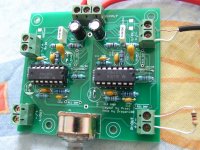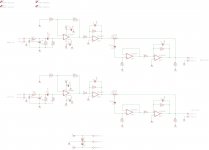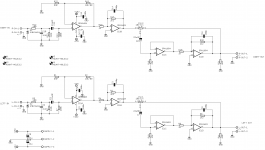Sometimes designer tries to solve a purely technical problem but at the same time creates a circuit that also has desirable subjective qualities. One such circuit is active gain control by the late Peter Baxandall. Basic idea was to create log action from the linear pot. Even the best log pots have audible discontinuities. Baxandall’s circuit solves this issue providing a silky smooth log action from the linear pot.
The circuit I used is from Texas Instruments tidu34, designed by Ian Williams. There was a TI demo (mono) pcb which used SMD parts. I used stereo TH pcb designed by the forum member Prasi (with a little help from Dragan100). Hat down to Prasi for excellent two sided board.
Original circuit is just attenuator but the circuit I used has 6dBs gain obtained by adjusting R8 in the original schematic. For testing purposes I used cheap TL074 DIP14 opamps because high performance quad opams in DIP14 package are hard to find. I had some problems with obviously fake TL074 bought from Ali Express and marked TI. Another pair of TL074 made by ST gave perfect results. Since TL07x are not very load tolerant I used higher value resisitors than ones in the original schematic. But even with resisitors several times the value marked in the original schematics subjective results were excellent. If DIP14 quad opamps like NJM 2060 or TLE2074 are used one can benefit even more from the lower noise that original resistor values provide.
What I like about this circuit is excellent control of volume combined with great sound. Unlike most log pots Baxandall’s circuit is pleasure to use. It is possible to adjust volume very precisely. Sound of the circuit is seductively smooth yet at the same time detailed and dynamic. It’s pity that Baxandall’s active gain control is not used more in industrial HiFi products. It is my impression that inverting stage of Baxandall’s circuit is responsible for the fine subjective qualities. First CD that I tried with tidu034 circuit was Tomasz Stanko’s „Soul of Things“ (ECM Records). I was surprised how palpable piano sounded and how detailed the sound was at low listening levels.
The circuit I used is from Texas Instruments tidu34, designed by Ian Williams. There was a TI demo (mono) pcb which used SMD parts. I used stereo TH pcb designed by the forum member Prasi (with a little help from Dragan100). Hat down to Prasi for excellent two sided board.
Original circuit is just attenuator but the circuit I used has 6dBs gain obtained by adjusting R8 in the original schematic. For testing purposes I used cheap TL074 DIP14 opamps because high performance quad opams in DIP14 package are hard to find. I had some problems with obviously fake TL074 bought from Ali Express and marked TI. Another pair of TL074 made by ST gave perfect results. Since TL07x are not very load tolerant I used higher value resisitors than ones in the original schematic. But even with resisitors several times the value marked in the original schematics subjective results were excellent. If DIP14 quad opamps like NJM 2060 or TLE2074 are used one can benefit even more from the lower noise that original resistor values provide.
What I like about this circuit is excellent control of volume combined with great sound. Unlike most log pots Baxandall’s circuit is pleasure to use. It is possible to adjust volume very precisely. Sound of the circuit is seductively smooth yet at the same time detailed and dynamic. It’s pity that Baxandall’s active gain control is not used more in industrial HiFi products. It is my impression that inverting stage of Baxandall’s circuit is responsible for the fine subjective qualities. First CD that I tried with tidu034 circuit was Tomasz Stanko’s „Soul of Things“ (ECM Records). I was surprised how palpable piano sounded and how detailed the sound was at low listening levels.
Attachments
The TI circuit is here:
www.ti.com/general/docs/lit/getliterature.tsp?baseLiteratureNumber=tidu034
www.ti.com/general/docs/lit/getliterature.tsp?baseLiteratureNumber=tidu034
How do I download that page?
I get a redirect that I need to click on to allow. But it remains a blank page.
Hmm. Firefox initiates a download for me.
Here's the direct download link:
http://www.ti.com/lit/ug/tidu034/tidu034.pdf
Let me know if that works for you.
How do I download that page?
I get a redirect that I need to click on to allow. But it remains a blank page.
Didnt you follow Apex' thread? He has offered several simplified versions of the tidu preamp. Its my reference opamp based pre but my current best is different. Uncommon because it doesnt follow the common wisdom. I put volume control in front of an inverting opamp!! It sounded better so i had to solve the expected issues of doing it that way.
I have tried many passive and opamp based preamplifiers, pot at the input, pot at the output, pot between buffer and gain block, pot between two gain blocks, PGA2310 volume controler, and nothing beats Baxandall circuit for sound quality and convenience. It's by far the most "musical" preamp without tone controls. As I said the inherent musicality is due to inverting stage. Inverting configuration is always more musical than noninverting. Probably due to zero common mode distortion. Bonsai commented in the writeup for his Symphony Line preamp that Baxandall active gain control can suffer from excessive noise amplification at the sensitive summing node. However, for sheer musicality I think that Baxandall can win even in less than perfect implementation (imperfect pcb, no shielding, etc.).
And all that at the price that is lower than the price of high quality pot (ALPS Blue Velvet). If you want excellent interchannel tracking you can buy several low cost dual gang linear 10k pots and measure them to find one with good tracking. In my experience good one can be found in a batch of 3 pots. I used cheap Chinese 16mm 10k linear pot with excellent results.
This circuit is perfect example of "good engineering meets excellent subjective qualities".
And all that at the price that is lower than the price of high quality pot (ALPS Blue Velvet). If you want excellent interchannel tracking you can buy several low cost dual gang linear 10k pots and measure them to find one with good tracking. In my experience good one can be found in a batch of 3 pots. I used cheap Chinese 16mm 10k linear pot with excellent results.
This circuit is perfect example of "good engineering meets excellent subjective qualities".
The direct links takes me straught to the .pdfHmm. Firefox initiates a download for me.
Here's the direct download link:
http://www.ti.com/lit/ug/tidu034/tidu034.pdf
Let me know if that works for you.
I don't know why the re-direct stays blank.
Can you follow the 1001 proposals in the Apex Threads?Didnt you follow Apex' thread?...........
Can you follow the 1001 proposals in the Apex Threads?
Puzey's active volume control does not use a buffer for the pentiomenter cursor.
Having looked carefully at the schematics, it seems to me that the buffer is unnecessary.
Having looked carefully at the schematics, it seems to me that the buffer is unnecessary.
I agree. I found that tracks with good so called log pots are not so badly matched but that it their curve iwhich s far from respecting our own log perception.nothing beats Baxandall circuit for sound quality and convenience.
Bloated app note and overrated circuit, IMHO. Taper isnt that much different from linear, and a 30% "soft" log pot does just the same and those behave much better than the 10% "hard" standard log types.
A few points which exist in the real world as opposed to the ideal, theoretical world:
(1) Logarithmic tapers are generally inaccurate and have reduced output smoothness compared to linear taper. This is a manufacturing characteristic which is often lamented. Some "logarithmic" potentiometers are constructed using linear tracks, and are only pseudo-logarithmic.
(2) The mismatches as per (1) has implications for dual units. A dual linear, for example, has greater matching between the sides than a dual log. Again, a known issue. The matching would not, of course, matter in a guitar tone stack which only used a single unit, but it does matter in HiFi.
(3) Log potentiometers are less popular than the linear variety, and the available selection of values is often correspondingly reduced.
The circuit almost behaves like a linear pot. Wonder why the author didn't plot that in comparison? I know.
Soft log pots, i repeat, are much more like lin pots in consistency etc.
And for a mfgr no problem to order less popular tapers... for diy guys yes, you have a point.
Soft log pots, i repeat, are much more like lin pots in consistency etc.
And for a mfgr no problem to order less popular tapers... for diy guys yes, you have a point.
At low volume settings circuit behaves like linear pot but as described in tidu034, it's beneficial for pot "offness". We want dead silence at zero setting, aren't we? If you want to use log part of track, don't give the circuit any gain, build it as described in tidu034.
Doug Self proved experimentally that with cheap linear RadioOhm pots, channel tracking in the log part is between 0,3dB and 0,6dB. That's excellent result. Expensive ALPS Blue Velvet log pot has tracking error of 2dBs.
Doug Self proved experimentally that with cheap linear RadioOhm pots, channel tracking in the log part is between 0,3dB and 0,6dB. That's excellent result. Expensive ALPS Blue Velvet log pot has tracking error of 2dBs.
C15, C7 jumpered
C11, C3 10uF/16V tantal
Because I don't have 22uF small bipolar elcos. If you have small bipolars you should populate all these positions.
Instead of 1k resistors I used 4k7 (TL074 don't have good load tolerance) but if you have MC33079 you should use 1k as on the original schematic.
R20, R8 are 10k - I use 6dB gain (tidu034 recommends using higher values for R17 and R3 for the same reason)
All other components use tidu034 values. 100pF caps are ML COG ceramics. These caps are needed to achieve less than unity gain stability for the inverting stages.
100nF bypass caps are X7R ML ceramics.
C11, C3 10uF/16V tantal
Because I don't have 22uF small bipolar elcos. If you have small bipolars you should populate all these positions.
Instead of 1k resistors I used 4k7 (TL074 don't have good load tolerance) but if you have MC33079 you should use 1k as on the original schematic.
R20, R8 are 10k - I use 6dB gain (tidu034 recommends using higher values for R17 and R3 for the same reason)
All other components use tidu034 values. 100pF caps are ML COG ceramics. These caps are needed to achieve less than unity gain stability for the inverting stages.
100nF bypass caps are X7R ML ceramics.
- Home
- Source & Line
- Analog Line Level
- Baxandall gain control according TI tidu34 certified design


